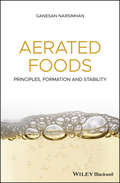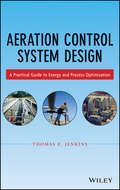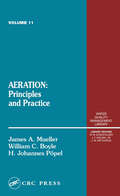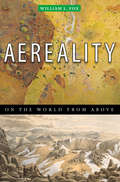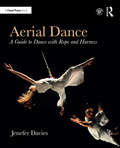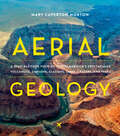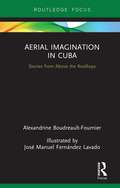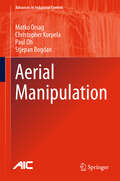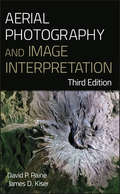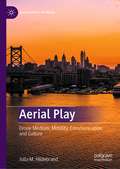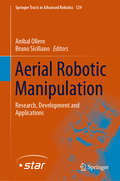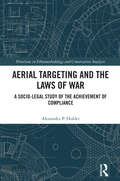- Table View
- List View
Aera Book 2: The Return of the Ancient Gods (The Return of the Ancient Gods #2)
by Markus HeitzPart 2 in the fast-paced and thrilling new episodic novella series from award-winning Markus Heitz. The gods are back, the world is in uproar - and only one man will seek the truthNOVEMBER, 2019I've never believed in any kind of god.But that's a problem when they start manifesting.It was a problem for everyone else too, especially those whose gods did not appear. We are divided, a fractured globe, because you'd question everything you'd believed, wouldn't you? Or would you fight?Because I don't think these really are the gods we've worshipped - Zeus, The Mórrígan, Thor, they can go to hell. We're in the middle of an invasion, and I'm the only one who believes in that reality.My name is Malleus Bourreau, I'm an atheist, an investigator, and I will find the answers.The second instalment in the ten-part novella serialisation 'The Return of the Ancient Gods' by award-winning author Markus Heitz.
Aera Book 3: The Return of the Ancient Gods (The Return of the Ancient Gods #3)
by Markus HeitzPart 3 in the fast-paced and thrilling new episodic novella series from award-winning Markus Heitz. The gods are back, the world is in uproar - and only one man will seek the truthNOVEMBER, 2019I've never believed in any kind of god.But that's a problem when they start manifesting.It was a problem for everyone else too, especially those whose gods did not appear. We are divided, a fractured globe, because you'd question everything you'd believed, wouldn't you? Or would you fight?Because I don't think these really are the gods we've worshipped - Zeus, The Mórrígan, Thor, they can go to hell. We're in the middle of an invasion, and I'm the only one who believes in that reality.My name is Malleus Bourreau, I'm an atheist, an investigator, and I will find the answers.The third instalment in the ten-part novella serialisation 'The Return of the Ancient Gods' by award-winning author Markus Heitz.
Aera Book 4: The Return of the Ancient Gods (The Return of the Ancient Gods #4)
by Markus HeitzPart 4 in the fast-paced and thrilling new episodic novella series from award-winning Markus Heitz. The gods are back, the world is in uproar - and only one man will seek the truthNOVEMBER, 2019I've never believed in any kind of god.But that's a problem when they start manifesting.It was a problem for everyone else too, especially those whose gods did not appear. We are divided, a fractured globe, because you'd question everything you'd believed, wouldn't you? Or would you fight?Because I don't think these really are the gods we've worshipped - Zeus, The Mórrígan, Thor, they can go to hell. We're in the middle of an invasion, and I'm the only one who believes in that reality.My name is Malleus Bourreau, I'm an atheist, an investigator, and I will find the answers.The fourth instalment in the ten-part novella serialisation 'The Return of the Ancient Gods' by award-winning author Markus Heitz.
Aera Book 5: The Return of the Ancient Gods (The Return of the Ancient Gods #5)
by Markus HeitzPart 5 in the fast-paced and thrilling new episodic novella series from award-winning Markus Heitz. The gods are back, the world is in uproar - and only one man will seek the truth.NOVEMBER, 2019I've never believed in any kind of god.But that's a problem when they start manifesting.It was a problem for everyone else too, especially those whose gods did not appear. We are divided, a fractured globe, because you'd question everything you'd believed, wouldn't you? Or would you fight?Because I don't think these really are the gods we've worshipped - Zeus, The Mórrígan, Thor, they can go to hell. We're in the middle of an invasion, and I'm the only one who believes in that reality.My name is Malleus Bourreau, I'm an atheist, an investigator, and I will find the answers.The fifth instalment in the ten-part novella serialisation 'The Return of the Ancient Gods' by award-winning author Markus Heitz.
Aera Book 6: The Return of the Ancient Gods (The Return of the Ancient Gods #6)
by Markus HeitzPart 6 in the fast-paced and thrilling new episodic novella series from award-winning Markus Heitz. The gods are back, the world is in uproar - and only one man will seek the truth. NOVEMBER, 2019I've never believed in any kind of god.But that's a problem when they start manifesting.It was a problem for everyone else too, especially those whose gods did not appear. We are divided, a fractured globe, because you'd question everything you'd believed, wouldn't you? Or would you fight?Because I don't think these really are the gods we've worshipped - Zeus, The Mórrígan, Thor, they can go to hell. We're in the middle of an invasion, and I'm the only one who believes in that reality.My name is Malleus Bourreau, I'm an atheist, an investigator, and I will find the answers.The sixth instalment in the ten-part novella serialisation 'The Return of the Ancient Gods' by award-winning author Markus Heitz.
Aera Book 7: The Return of the Ancient Gods (The Return of the Ancient Gods #7)
by Markus HeitzPart 7 in the fast-paced and thrilling new episodic novella series from award-winning Markus Heitz. The gods are back, the world is in uproar - and only one man will seek the truth.NOVEMBER, 2019I've never believed in any kind of god.But that's a problem when they start manifesting.It was a problem for everyone else too, especially those whose gods did not appear. We are divided, a fractured globe, because you'd question everything you'd believed, wouldn't you? Or would you fight?Because I don't think these really are the gods we've worshipped - Zeus, The Mórrígan, Thor, they can go to hell. We're in the middle of an invasion, and I'm the only one who believes in that reality.My name is Malleus Bourreau, I'm an atheist, an investigator, and I will find the answers.The seventh instalment in the ten-part novella serialisation 'The Return of the Ancient Gods' by award-winning author Markus Heitz.
Aera Book 8: The Return of the Ancient Gods (The Return of the Ancient Gods #8)
by Markus HeitzPart 8 in the fast-paced and thrilling new episodic novella series from award-winning Markus Heitz. The gods are back, the world is in uproar - and only one man will seek the truth.NOVEMBER, 2019I've never believed in any kind of god.But that's a problem when they start manifesting.It was a problem for everyone else too, especially those whose gods did not appear. We are divided, a fractured globe, because you'd question everything you'd believed, wouldn't you? Or would you fight?Because I don't think these really are the gods we've worshipped - Zeus, The Mórrígan, Thor, they can go to hell. We're in the middle of an invasion, and I'm the only one who believes in that reality.My name is Malleus Bourreau, I'm an atheist, an investigator, and I will find the answers.The eighth instalment in the ten-part novella serialisation 'The Return of the Ancient Gods' by award-winning author Markus Heitz.
Aera Book 9 (The Return of the Ancient Gods #9)
by Markus HeitzPart 9 in the fast-paced and thrilling new episodic novella series from award-winning Markus Heitz. The gods are back, the world is in uproar - and only one man will seek the truth.NOVEMBER, 2019I've never believed in any kind of god.But that's a problem when they start manifesting.It was a problem for everyone else too, especially those whose gods did not appear. We are divided, a fractured globe, because you'd question everything you'd believed, wouldn't you? Or would you fight?Because I don't think these really are the gods we've worshipped - Zeus, The Mórrígan, Thor, they can go to hell. We're in the middle of an invasion, and I'm the only one who believes in that reality.My name is Malleus Bourreau, I'm an atheist, an investigator, and I will find the answers.The ninth instalment in the ten-part novella serialisation 'The Return of the Ancient Gods' by award-winning author Markus Heitz.
Aera Free Prologue: The Return of the Ancient Gods (The Return of the Ancient Gods #11)
by Markus HeitzThe gods are back, the world is in uproar - and only one man will seek the truth. NOVEMBER, 2019. I've never believed in any kind of god. But that's a problem when they start manifesting. It was a problem for everyone else too, especially those whose gods did not appear. We are divided, a fractured globe, because you'd question everything you'd believed, wouldn't you? Or would you fight? Because I don't think these really are the gods we've worshipped - Zeus, The Mórrígan, Thor, they can go to hell. We're in the middle of an invasion, and I'm the only one who believes in that reality. My name is Malleus Bourreau, I'm an atheist, an investigator, and I will find the answers. The prologue to the ten-part novella serialisation 'The Return of the Ancient Gods' by award-winning author Markus Heitz.
Aera: A wonderfully twisty thriller by the internationally bestselling author of The Dwarves (Aera: The Return of the Gods)
by Markus HeitzThe complete omnibus of the ten-part novella serialisation AERA: The Return of the Ancient Gods, from the internationally bestselling author of The Dwarves. The gods are back, the world is in uproar - and only one man has the strength to seek the truth.NOVEMBER, 2019I've never believed in any kind of god.But that's a problem when they start manifesting.It was a problem for everyone else too, especially those whose gods did not appear. We are divided, a fractured globe, because you'd question everything you'd believed, wouldn't you? Or would you fight?Because I don't think these really are the gods we've worshipped. Zeus, The Mórrígan, Thor - they can go to hell. We're in the middle of an invasion, and I'm the only one who believes in that reality.My name is Malleus Bourreau. I'm an atheist, an investigator - and I will find the answers.
Aerated Foods: Principles, Formation and Stability
by Ganesan NarsimhanExplore the roles aeration can play in the production, stability, and consumer experience of foods Aeration is an increasingly prevalent part of food manufacturing, bringing a light texture, enhanced appearance, and richer flavors to a wide range of products. Essential to the creation of everything from ice cream and popcorn to cheese and beer, the incorporation of fine air bubbles into the foods we consume can also boost satiety and thus reduce calorific intake. Aerated Foods examines this process in detail, offering a complete overview of all aspects of aeration. With sections that address the effects of aeration upon product structure and stability, this informative book explains how food formulation influences the shelf life, texture, and overall experience of different foods. Chapters also outline the various methods by which aeration can be achieved, breaking down the science and technology involved in the incorporation of air Details the mechanisms and overall results of aeration as a method of food processing Covers innovative and experimental aeration techniques Looks at the role of aeration in baking Aerated Foods provides food scientists, researchers, and product developers with an invaluable guide to this multifaceted and fast-growing method of food production.
Aeration Control System Design
by Thomas E. JenkinsLearn how to design and implement successful aeration control systemsCombining principles and practices from mechanical, electrical, and environmental engineering, this book enables you to analyze, design, implement, and test automatic wastewater aeration control systems and processes. It brings together all the process requirements, mechanical equipment operations, instrumentation and controls, carefully explaining how all of these elements are integrated into successful aeration control systems. Moreover, Aeration Control System Design features a host of practical, state-of-the-technology tools for determining energy and process improvements, payback calculations, system commissioning, and more.Author Thomas E. Jenkins has three decades of hands-on experience in every phase of aeration control systems design and implementation. He presents not only the most current theory and technology, but also practical tips and techniques that can only be gained by many years of experience. Inside the book, readers will find:Full integration of process, mechanical, and electrical engineering considerationsAlternate control strategies and algorithms that provide better performance than conventional proportional-integral-derivative controlPractical considerations and analytical techniques for system evaluation and designNew feedforward control technologies and advanced process monitoring systemsThroughout the book, example problems based on field experience illustrate how the principles and techniques discussed in the book are used to create successful aeration control systems. Moreover, there are plenty of equations, charts, figures, and diagrams to support readers at every stage of the design and implementation process.In summary, Aeration Control System Design makes it possible for engineering students and professionals to design systems that meet all mechanical, electrical, and process requirements in order to ensure effective and efficient operations.
Aeration: Principles and Practice, Volume 11
by James Mueller William C. Boyle Ing. H. Johannes PopelThe immense environmental challenges facing the world now and in years to come can only be met through marshalling the talents of the best environmental engineers and scientists, and through the use of innovative, cost-effective solutions. Written by three leading aeration experts, Aeration: Principles and Practice, covers the principles and practi
Aereality: On the World from Above
by William FoxWilliam Fox's writing for the last several years has been focused on how we construct aerial views, either physically (by flying) or in our imaginations.In Aereality, he flies over earthworks in Nevada and Utah, soars through the world's largest open pit mine, and surveys Los Angeles, circumnavigating large swaths of true American urban sprawl. On the East Coast, he examines the elevated art of the Hudson River Valley and New York City. And finally, in Australia, Fox examines the history and current practice of both Euro–Australian and Aboriginal aerial views, and searches for the cognitive roots of our aerial imagination.Accompanying Fox throughout his travels is a rolling cast of enlightened fliers: geographers, museum curators, landscape photographers, anthropologists, and artists. He traverses the sky in prop planes, helicopters, and hot air balloons, all with the ultimate goal of knowing and experiencing the earth from the air.
Aerial Aftermaths: Wartime from Above
by Caren KaplanFrom the first vistas provided by flight in balloons in the eighteenth century to the most recent sensing operations performed by military drones, the history of aerial imagery has marked the transformation of how people perceived their world, better understood their past, and imagined their future. In Aerial Aftermaths Caren Kaplan traces this cultural history, showing how aerial views operate as a form of world-making tied to the times and places of war. Kaplan’s investigation of the aerial arts of war—painting, photography, and digital imaging—range from England's surveys of Scotland following the defeat of the 1746 Jacobite rebellion and early twentieth-century photographic mapping of Iraq to images taken in the immediate aftermath of 9/11. Throughout, Kaplan foregrounds aerial imagery's importance to modern visual culture and its ability to enforce colonial power, demonstrating both the destructive force and the potential for political connection that come with viewing from above.
Aerial Dance: A Guide to Dance with Rope and Harness
by Jenefer DaviesAerial Dance: A Guide to Dance with Rope and Harness provides an introduction for the beginning aerialist. It covers rigging, equipment, advice on optimal conditioning, and a step-by-step guide to technique, including anatomical references, space and time considerations, and elements of force when working with and against gravity. Specific movements and choreography are framed anatomically and together reflect the pattern and order of an aerial technique class. Challenges inherent to this type of dancing are discussed, as well as wellness instruction and methods of altering these techniques for intermediate and advanced dancing. A companion website hosts video that corresponds with the technique and phrasing in the book.
Aerial Dogfights of World War II
by Jack PearlIT WAS KILL OR BE KILLED, IN A BATTLE FOR SUPREMACY IN THE SKIES…In a sense, technical advances have written finis to the Golden Age of the aerial dogfight. Modern jets, radar sights, electronically operated triggers and missiles are eliminating the human factor.In a World War II fighter plane the dimensions of war were reduced to basics—man versus man. This was war at its more personal level, in which a pilot met the enemy in an intimate struggle for survival.Here in this unforgettable book is a fitting tribute to these aces of the past—hair-raising accounts of aerial dogfights which occurred in the great land and sea battles in Europe, Africa and the Pacific.
Aerial Geology: A High-Altitude Tour of North America’s Spectacular Volcanoes, Canyons, Glaciers, Lakes, Craters, and Peaks
by Mary Caperton Morton“Get your head into the clouds with Aerial Geology.” —The New York Times Book ReviewAerial Geology is an up-in-the-sky exploration of North America’s 100 most spectacular geological formations. Crisscrossing the continent from the Aleutian Islands in Alaska to the Great Salt Lake in Utah and to the Chicxulub Crater in Mexico, Mary Caperton Morton brings you on a fantastic tour, sharing aerial and satellite photography, explanations on how each site was formed, and details on what makes each landform noteworthy. Maps and diagrams help illustrate the geological processes and clarify scientific concepts. Fact-filled, curious, and way more fun than the geology you remember from grade school, Aerial Geology is a must-have for the insatiably curious, armchair geologists, million-mile travelers, and anyone who has stared out the window of a plane and wondered what was below.
Aerial Imagination in Cuba: Stories from Above the Rooftops (Routledge Focus on Anthropology)
by Alexandrine Boudreault-FournierAerial Imagination in Cuba is a visual, ethnographic, sensorial, and poetic engagement with how Cubans imagine the sky as a medium that allows things to circulate. What do wi-fi antennas, cactuses, pigeons, lottery, and congas have in common? This book offers a series of illustrated ethno-fictional stories to explore various practices and beliefs that have seemingly nothing in common. But if you look at the sky, there is more than meets the eye. By discussing the natural, religious, and human-made visible and invisible aerial infrastructures—or systems of circulation—through short illustrated vignettes, Aerial Imagination in Cuba offers a highly creative way to explore the aerial space in Santiago de Cuba today.
Aerial Manipulation (Advances in Industrial Control)
by Matko Orsag Christopher Korpela Paul Oh Stjepan BogdanThis text is a thorough treatment of the rapidly growing area of aerial manipulation. It details all the design steps required for the modeling and control of unmanned aerial vehicles (UAV) equipped with robotic manipulators. Starting with the physical basics of rigid-body kinematics, the book gives an in-depth presentation of local and global coordinates, together with the representation of orientation and motion in fixed- and moving-coordinate systems. Coverage of the kinematics and dynamics of unmanned aerial vehicles is developed in a succession of popular UAV configurations for multirotor systems. Such an arrangement, supported by frequent examples and end-of-chapter exercises, leads the reader from simple to more complex UAV configurations. Propulsion-system aerodynamics, essential in UAV design, is analyzed through blade-element and momentum theories, analysis which is followed by a description of drag and ground-aerodynamic effects. The central part of the book is dedicated to aerial-manipulator kinematics, dynamics, and control. Based on foundations laid in the opening chapters, this portion of the book is a structured presentation of Newton-Euler dynamic modeling that results in forward and backward equations in both fixed- and moving-coordinate systems. The Lagrange-Euler approach is applied to expand the model further, providing formalisms to model the variable moment of inertia later used to analyze the dynamics of aerial manipulators in contact with the environment. Using knowledge from sensor data, insights are presented into the ways in which linear, robust, and adaptive control techniques can be applied in aerial manipulation so as to tackle the real-world problems faced by scholars and engineers in the design and implementation of aerial robotics systems. The book is completed by path and trajectory planning with vision-based examples for tracking and manipulation.
Aerial Photography and Image Interpretation
by James D. Kiser David P. PaineThe new, completely updated edition of the aerial photography classicExtensively revised to address today's technological advances, Aerial Photography and Image Interpretation, Third Edition offers a thorough survey of the technology, techniques, processes, and methods used to create and interpret aerial photographs. The new edition also covers other forms of remote sensing with topics that include the most current information on orthophotography (including digital), soft copy photogrammetry, digital image capture and interpretation, GPS, GIS, small format aerial photography, statistical analysis and thematic mapping errors, and more. A basic introduction is also given to nonphotographic and space-based imaging platforms and sensors, including Landsat, lidar, thermal, and multispectral. This new Third Edition features:Additional coverage of the specialized camera equipment used in aerial photographyA strong focus on aerial photography and image interpretation, allowing for a much more thorough presentation of the techniques, processes, and methods than is possible in the broader remote sensing texts currently availableStraightforward, user-friendly writing styleExpanded coverage of digital photographyTest questions and summaries for quick review at the end of each chapterWritten in a straightforward style supplemented with hundreds of photographs and illustrations, Aerial Photography and Image Interpretation, Third Edition is the most in-depth resource for undergraduate students and professionals in such fields as forestry, geography, environmental science, archaeology, resource management, surveying, civil and environmental engineering, natural resources, and agriculture.
Aerial Play: Drone Medium, Mobility, Communication, and Culture (Geographies of Media)
by Julia M. HildebrandThis book explores recreational uses of consumer drones from the lenses of media ecology, mobile communication, mobilities research, and science and technology studies. In this provocative ethnography, Julia M. Hildebrand discusses camera drones as mobile media for meaningful play. She thus widens perspectives onto the flying camera as foremost unmanned aircraft, spying tool, or dangerous toy towards a more comprehensive understanding of its potentials.How should we situate drone practices in recreational spaces? What ways of seeing, moving, and being do hobby drones open up? Across chapters about drone geography, communication, mobility, visuality, and human-machine relations, Aerial Play introduces novel frameworks for drone affordances, such as communication on the fly, disembodied mobilities, auratic vertical play, and drone-mindedness.In the mobile companionship with her own drone, Hildebrand contributes an innovative “auto-technographic” method for the self-reflective study of media and mobility. Ultimately, her grounded and aerial fieldwork illuminates new technological, mobile, visual, and social relations in everyday spaces.
Aerial Propaganda and the Wartime Occupation of France, 1914-18 (Routledge Studies in First World War History)
by Bernard WilkinAerial Propaganda and the Wartime Occupation of France, 1914-1918 explores the combined role played by the French and British Governments and Armies in creating and distributing millions of aerial newspapers and leaflets aimed at the French population trapped behind German lines. Drawing on extensive research and French, German and British primary sources, the book highlights a previously unknown aspect of psychological warfare that challenges the established interpretation that the occupied populations lived in a state of total isolation and that the Allied governments had no desire to provide them with morale support. Instead a very different picture emerges from this study, which demonstrates that aerial propaganda not only played a fundamental role in raising morale in the occupied territories but also fuelled resistance and clandestine publications. This book demonstrates that the existing historiographical portrayal of the occupied civilian as an uninformed victim must be replaced by a more nuanced interpretation.
Aerial Robotic Manipulation: Research, Development and Applications (Springer Tracts in Advanced Robotics #129)
by Anibal Ollero Bruno SicilianoAerial robotic manipulation integrates concepts and technologies coming from unmanned aerial systems and robotics manipulation. It includes not only kinematic, dynamics, aerodynamics and control but also perception, planning, design aspects, mechatronics and cooperation between several aerial robotics manipulators. All these topics are considered in this book in which the main research and development approaches in aerial robotic manipulation are presented, including the description of relevant systems. In addition of the research aspects, the book also includes the deployment of real systems both indoors and outdoors, which is a relevant characteristic of the book because most results of aerial robotic manipulation have been validated only indoor using motion tracking systems. Moreover, the book presents two relevant applications: structure assembly and inspection and maintenance, which has started to be applied in the industry. The Chapters of the book will present results of two main European Robotics Projects in aerial robotics manipulation: FP7 ARCAS and H2020 AEROARMS. FP7 ARCAS defined the basic concepts on aerial robotic manipulation, including cooperative manipulation. The H2020 AEROARMS on aerial robot with multiple arms and advanced manipulation capabilities for inspection and maintenance has two general objectives: (1) development of advanced aerial robotic manipulation methods and technologies, including manipulation with dual arms and multi-directional thrusters aerial platforms; and (2) application to the inspection and maintenance.
Aerial Targeting and the Laws of War: A Socio-Legal Study of the Achievement of Compliance (Directions in Ethnomethodology and Conversation Analysis)
by Alexander P. HolderA ground-breaking socio-legal investigation of the in situ legal considerations involved in targeting and the use of force, Aerial Targeting and the Laws of War develops a new kind of evidence base for international action relating to the protection of civilians.Investigating the materials surrounding a civilian casualty incident that took place in Afghanistan in 2010, the book explores how a single strike – which was conducted in light of intelligence gathered by a militarised drone crew and resulted in the deaths of at least 15 civilians – became a lawful strike, that is, a strike that was deemed to have been compliant with the laws of war both at the point at which munitions were released and following two internal investigations. Through an ethnomethodological engagement with the transcripts, interviews, reports, and other materials associated with the incident, Alexander P. Holder examines the methods by which military personnel produce and maintain legitimate targets for the use of force.Re-focusing debates surrounding civilian harm upon the praxeological details of the military practices, which generate such harms, this book will appeal to scholars of sociology, military studies, and socio-legal studies with interests in the rules of war and ethnomethodological approaches to research.










